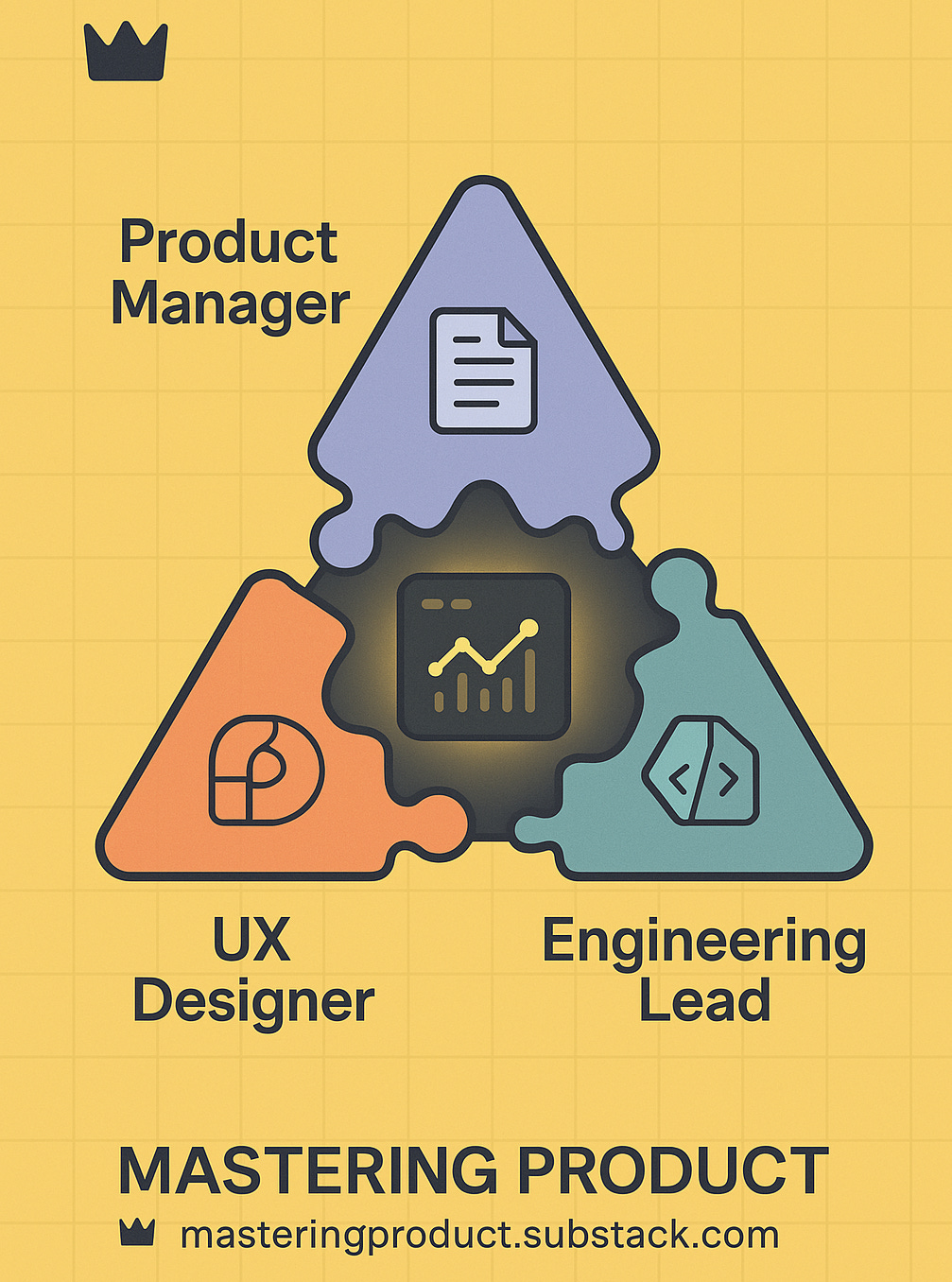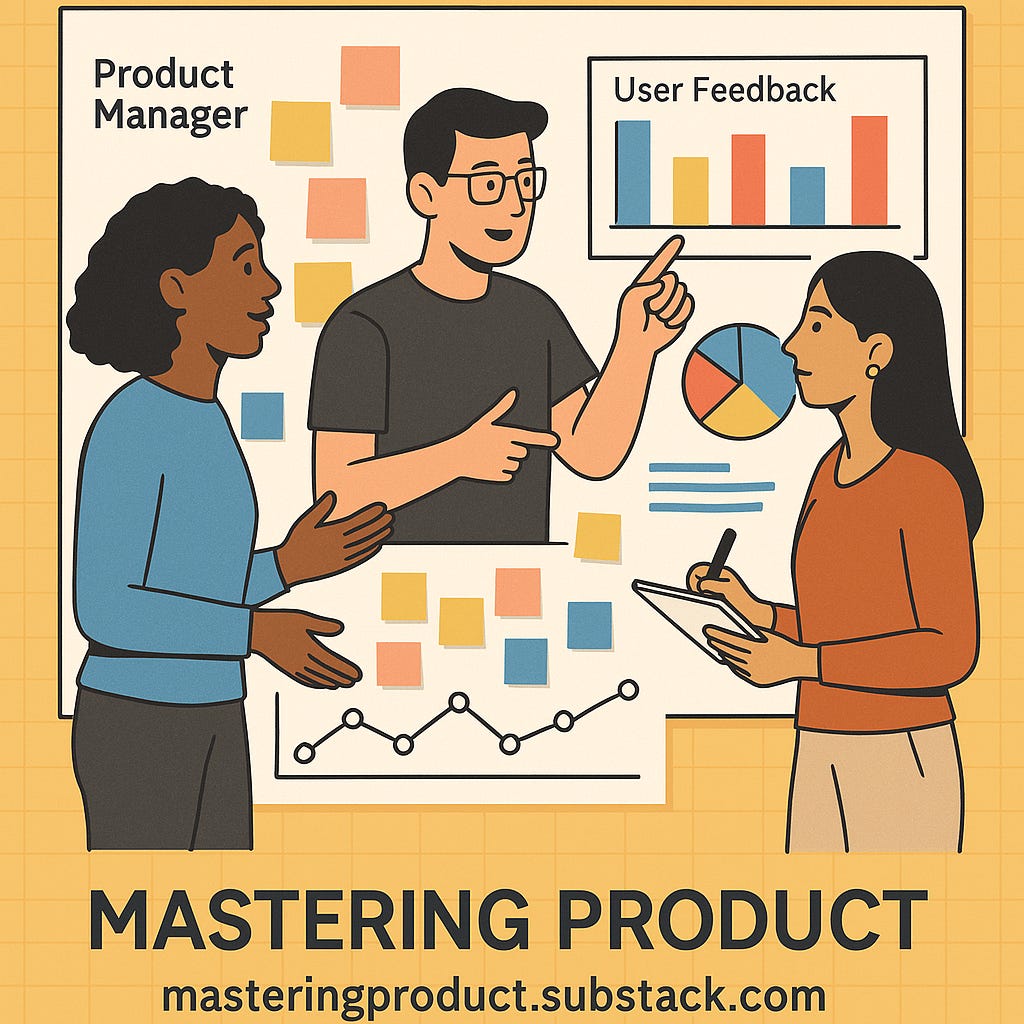The Product Trio 2.0: How Cross-Functional Collaboration Is Evolving
How the collaboration between Product, Engineering, and Design has evolved from shipping features to driving outcomes
Two years ago, I wrote about the basic Product Trio concept. Today, I want to share how I've seen this model evolve across organizations I've worked with, including my time at Booking.com. The way these three critical roles collaborate has changed dramatically—and understanding this evolution could be your competitive advantage.
The Original Product Trio: A Quick Refresher
If you're familiar with cross-functional product teams, you know the classic trio:
Product Manager: Owns strategy, vision, and roadmap. They identify user needs, set direction, and ensure business alignment.
Engineering Lead: Directs technical implementation, guides the engineering team, and ensures product quality. They translate requirements into technical solutions.
UX Designer: Creates the user experience through research and design principles. They ensure the product is intuitive and meets user needs.
This model served us well for years, but as I've witnessed firsthand, the landscape has shifted significantly.
From Outputs to Outcomes: The Fundamental Shift
The biggest change I've observed is the shift from output-focused to outcome-focused collaboration.
I remember when success meant shipping features on schedule. We'd celebrate launching a feature regardless of its impact. Now, at forward-thinking companies, success means delivering measurable outcomes that matter to users and the business.
This shift has completely transformed how the trio works together:
For Product Managers: I've had to evolve from writing detailed specs to framing clear problems and outcomes. Instead of dictating solutions, I now say: "We need to increase conversion by 3%. How might we approach this?"
For Engineering Leads: The engineers I work with now participate much earlier in the process. Rather than just implementing requirements, they help shape problem definition and explore technical approaches that might deliver outcomes more effectively.
For UX Designers: Designers have expanded their focus beyond interfaces to the entire product experience. They're now partners in defining problems and success metrics, not just creating solutions to predetermined requirements.
What This Looked Like at Booking.com
At Booking.com, I personally experienced the effectiveness of this outcome-focused Product Trio model. The product teams I worked in and with were already set up this way when I joined. Instead of using traditional feature-driven roadmaps, we operated with clear business outcomes like "Increase mobile conversion rate by 2%."
Interestingly, we also had a Product Marketing Manager as part of each product team's leadership structure—expanding the trio into what could be considered a "quartet." I'll cover how we made that role work effectively within the product team in a future article.
According to research by McKinsey & Company, organizations that implement outcome-based product teams similar to this model typically see significant improvements in key metrics. Their 2022 report on product development effectiveness showed that companies using these collaborative approaches experienced 30-45% faster time-to-market and approximately 25-40% higher likelihood of meeting product success metrics compared to organizations using traditional siloed approaches.
The key difference in these team structures? Shared ownership of outcomes rather than individual ownership of outputs. When everyone focuses on the same goal rather than their individual deliverables, collaboration improves dramatically.
New Collaboration Patterns I'm Seeing
Continuous Parallel Discovery and Delivery
Gone are the days of the waterfall-like process where PMs define requirements, designers create mockups, and engineers implement. In the most effective teams I've worked with:
Discovery and delivery happen simultaneously (what some call dual-track agile)
All three roles participate in user research sessions together
Teams run quick experiments rather than lengthy planning cycles
Blurring Role Boundaries
The most effective product trios I've worked with have increasingly fluid boundaries. Everyone develops "T-shaped" skills—deep expertise in their domain with broader knowledge across adjacent areas.
I've seen PMs learning enough about technical architecture to better understand constraints, engineers participating actively in user research, and designers diving into analytics to inform their work.
This cross-pollination reduces handoffs and creates more innovative solutions. When I started involving engineers in user interviews at Booking.com, the quality of our technical solutions improved dramatically because they understood the problems firsthand.
Data as the Fourth Member
While we still call it a "trio," in practice, data has become the fourth member of modern product teams. Everyone needs to be data-fluent:
PMs use data to identify opportunities and measure outcomes
Engineers leverage data for technical decisions and performance optimization
Designers incorporate data into research and experience optimization
On one team I led, we started treating our data as a product in itself, ensuring it was accessible and understandable to everyone. This seemingly small change led to significantly better decision-making across the board.
Making This Work: Practical Steps I've Learned
If you're looking to evolve your product trio (as I've had to do several times), here are the steps that have worked for me:
1. Establish Shared Outcome Ownership
Define measurable outcomes that the entire trio owns collectively. At Booking.com, we created shared OKRs that required collaboration across all three roles to achieve. We evaluated teams based on outcomes achieved, not individual outputs.
2. Create Collaborative Rituals
Some rituals that have worked well for me:
Weekly discovery sessions where all three roles participate in user research
Bi-weekly trio strategy sessions focused on problem exploration
"No-slides" working sessions where the trio collaborates in real-time
These regular touchpoints create a rhythm of collaboration that keeps everyone aligned.
3. Invest in Cross-Functional Skills
This has been crucial in every team I've led:
Create learning exchanges where each role teaches core concepts to others
Rotate responsibilities for certain tasks (I've had engineers run user interviews!)
Develop a common language that bridges the gaps between disciplines
4. Redesign Your Workspaces
Whether physical or digital, your workspace should reflect your collaborative approach:
Create dedicated spaces for trio collaboration
Implement tools that support joint discovery and decision-making
Ensure information is accessible to all trio members in real-time
5. Align Leadership and Reporting Structures
This is often overlooked but critical:
Make sure functional managers understand and support the trio model
Consider implementing trio-based performance reviews alongside functional reviews
Create forums for trios to share learnings across the organization
Pitfalls I've Encountered (So You Can Avoid Them)
Despite the best intentions, implementing an effective Product Trio 2.0 model can be challenging. Here are pitfalls I've personally encountered and how we addressed them:
Power Imbalances
I once worked with a team where technical considerations consistently overshadowed user needs and business goals. The engineering lead would steer discussions toward technical implementation details before we had fully explored the problem space. We addressed this by creating a structured decision-making process that clearly outlined when we needed to reach consensus versus when individual domain experts could make the call. This simple framework helped balance the influence across all three roles and ensured we gave proper attention to user, business, and technical perspectives before moving forward.
Skill Gaps
I've led teams where members lacked the cross-functional understanding needed for effective collaboration. Creating structured learning opportunities and pairing less experienced team members with mentors from other disciplines helped bridge these gaps.
Organizational Resistance
Traditional organizational structures often conflict with the fluid nature of modern product trios. Starting with pilot teams to demonstrate success, then using those results to advocate for broader organizational changes has been the most effective approach in my experience.
Looking Ahead: Where the Product Trio Is Going
Based on what I'm seeing in the industry, here are trends that will further shape how product trios collaborate:
AI-Augmented Collaboration: AI tools will increasingly support the trio by generating design alternatives, predicting technical challenges, and analyzing user feedback at scale.
Distributed Collaboration: As remote and hybrid work is becoming the norm, product trios will develop new practices for effective collaboration across time zones and physical locations.
Ecosystem Thinking: Product trios will expand their focus beyond individual products to consider entire ecosystems and platforms.
Your Competitive Advantage
The effectiveness of your product trio can be a significant competitive advantage. Organizations that foster truly collaborative, outcome-focused trios move faster, deliver more value, and create more innovative solutions.
This evolution from the original Product Trio to what I'm calling Product Trio 2.0 isn't just a minor update—it's a fundamental rethinking of how product teams collaborate to deliver value. By embracing this evolution, you can position your teams for greater success in an increasingly complex product development environment.
What's your experience with the Product Trio model? Has your organization evolved how these roles collaborate? Reply to this email to share your thoughts—I read every response and often feature reader insights in future newsletters.
Want to implement the Product Trio 2.0 model in your organization? Download my free Product Trio Implementation Checklist for a step-by-step guide to getting started. Your welcome email includes the link If you signed up recently, otherwise leave a comment and ill ping you the link to download.



